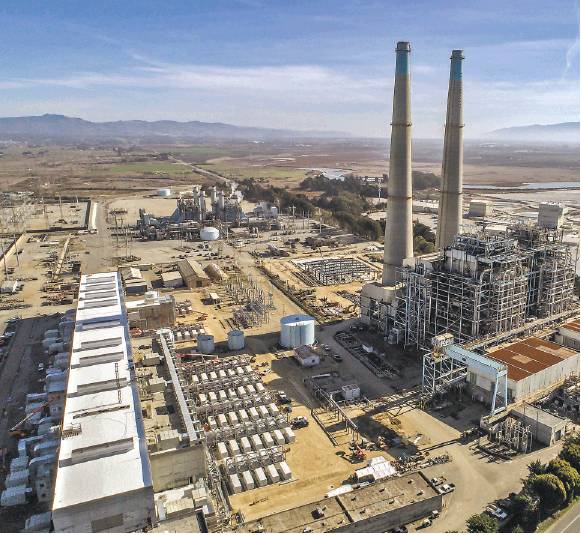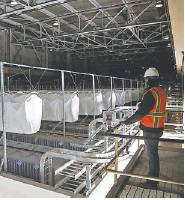Smokestack plant shifts to batteries
By J.D. Morris
The twin smokestacks that have long stood like giants along the Monterey Bay shoreline will never again help turn fossil fuels into electricity — and planet-warming carbon dioxide.
While the 500-foot structures in the coastal hamlet of Moss Landing aren’t going anywhere, much of the facility around them in Monterey County is being transformed into something else: a huge installation of batteries that will aid California’s transition to a cleaner energy grid.
Vistra Corp., a Texas energy company that owns the Moss Landing power plant, announced this month that its long-awaited battery system on the site has begun to come online. At 300 megawatts by the time it’s fully functional within the coming months, it will be the largest facility of its kind in the world, according to Vistra.
The juxtaposition of old and new energy technologies may seem symbolic, but it’s actually pragmatic, making use of the old plant’s surrounding infrastructure.
“This is the way of the future — to take these sites that are already permitted as industrial sites and had old power plants and put on them the new technology,” said Curt Morgan, the company’s CEO. “Why would you want to build extra power lines to connect to new power plants? That doesn’t make a lot of sense to me.”
Vistra’s $400 million Moss Landing battery system is designed to capture excess power when the grid’s supply is abundant — such as the daylight hours when solar farms operate at peak capacity. As day turns to night and solar output drops off, the batteries, which are able to discharge electricity for up to four hours, can release their power back to the grid.
In that way, the batteries should help alleviate the problems California faced last summer, when surging electricity demand amid a widespread heat wave led to two days of rolling blackouts. The shortage was caused in part by poor planning on the part of state energy leaders to ensure enough supplies were available when demand for electricity peaked as the sun set and solar farms wound down.
The batteries coming online in Moss Landing should help, though they won’t be enough to avoid repeating last summer’s problems on their own. But officials at the California Independent System Operator, the nonprofit that manages most of the state’s electric grid, have said energy storage projects will help.
“We know coming out of last summer that we ran into problems in that early evening — the 7, 8 o’clock time frame,” said Elliot Mainzer, the system operator’s new CEO. “This net peak of the system is now the biggest operational constraint.”
Mainzer said the Moss Landing project is among several storage facilities in the works around the state. He expects the market will continue to grow, making large battery projects even more commercially attractive.
“I’m very excited about ... what’s going to be a real energy storage revolution here in California and other parts of the world,” he said.
While storage systems like Vistra’s are a critical piece of California’s shift toward a power grid more reliant on the sun and wind, batteries will not eliminate fossil fuel electricity by themselves.
“With the transformation going on in the electrical grid, these large-scale batteries can bring a real boost to grid reliability, and they can support zero-carbon electricity’s integration into the grid,” said Catherine Hausman, an associate professor at the University of Michigan’s Ford School of Public Policy. “Of course, it’s really important to remember that batteries alone don’t get us to carbon neutrality. We still need low carbon or zero carbon generation to charge up the batteries.”
Vistra is not the only one installing an energy storage system in Moss Landing.
Adjacent to the power plant, Pacific Gas and Electric Co. and Tesla are partnering on their own 182.5-megawatt battery project. Using Tesla’s massive Megapack batteries at the site of a PG&E substation, the system is expected to come online this spring or early summer, said PG&E spokesman Paul Doherty. Battery installation began in July, he said.
Like the Vistra system, PG&E and Tesla’s batteries can discharge four hours’ worth of power and will be able to send excess electricity back onto the grid when needed.
“That will help alleviate things like we saw last summer,” Doherty said, referring to the rolling blackouts.
Doherty said original projections put the cost of PG&E’s Moss Landing batteries at about $80 million over its first two years. The company estimates that it will save ratepayers about $100 million over 20 years by avoiding costly upgrades to traditional electric infrastructure that would have otherwise been necessary to meet power demand.
Tesla did not respond to a request for comment.
The smokestacks at the power plant, situated at the mouth of a slough near the center of the Monterey Bay shoreline, make the facility stand out so much that a reporter once likened the facility to “the city of Oz minus the emeralds.” The stacks haven’t operated for years; Vistra will tear down much of the old infrastructure around them while leaving the twin columns in place. Morgan, the company’s CEO, said the smokestacks have become a landmark in the area and he thinks “most people want them” to stay.
Vistra still runs a 1,020megawatt gas-fueled power plant on the property that will continue to operate alongside the new batteries.
At the same time, the company is already working on a 100-megawatt expansion of the battery system, which would bring the total capacity to 400 megawatts by August.
The Moss Landing batteries are the centerpiece of the company’s Vistra Zero portfolio, which spans 4,000 megawatts of clean energy projects in California and Texas. Morgan said Vistra is also looking at installing batteries on power plant sites in other states, including Illinois and Pennsylvania.
J.D. Morris is a San Francisco Chronicle staff writer. Email: jd.morris@sfchronicle.com Twitter: @thejdmorris
“I’m very excited about ... what’s going to be a real energy storage revolution here in California.”
Elliott Mainzer, CEO of California Independent System Operator


